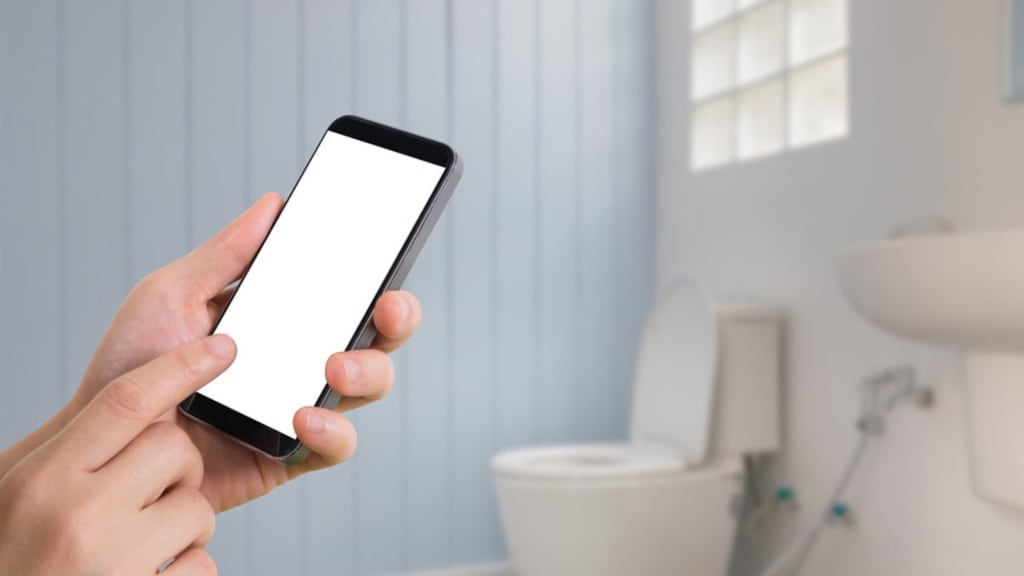Severe warnings that might make you stop browsing your phone in the bathroom?
More than 90% of the world's population owns or uses a mobile phone, and many of us cannot give it up, as we carry it with us everywhere, from bed to bathroom.

While health concerns around phone use usually focus on the distraction it can cause while driving, the potential effects of exposure to radiofrequency and blue light, or how addictive it is. The risks of infection with microbes on your phone are not appreciated much, but it is actually a worrying fact.
And a 2019 survey found that most people in the UK use their phones on the toilet. So it's not surprising to find out that studies have found our cell phones to be dirtier than toilet seats.
We give our phones to children to play with, eat while using our phones, and put them on all kinds of (dirty) surfaces, all of which can transfer microbes to the phone.
It is estimated that people touch their phones hundreds if not thousands of times a day. And while many of us wash our hands regularly after going to the bathroom, cooking, cleaning, or gardening, we are less likely to think about washing our hands after touching our phones. But given how disgusting germ-infested phones can be, maybe it's time to think more about mobile phone hygiene.
Germs, bacteria and viruses
Hands pick up bacteria and viruses all the time, which is how they can cause infection, and so do the phones we touch.
A number of studies conducted on the microbiological colonization of mobile phones showed that they can be contaminated with different types of disease-causing bacteria.
These include Escherichia coli, which causes diarrhea (which comes from human feces) and Staphylococcus, which infects the skin, as well as Actinomyces bacteria, which can cause tuberculosis and diphtheria, Citrobacter bacteria, which can lead to painful urinary tract infections, and Enterococcus, which is known to cause meningitis. .
Klebsiella, micrococcus, Proteus, Pseudomonas and Streptococcus have also been found on phones, and they can all have bad effects on humans.
Research has found that many pathogens on phones are often resistant to antibiotics, which means they cannot be treated with conventional medicines. This is worrisome because these bacteria can cause skin, gut and respiratory infections that can be life-threatening.
Research also found that even if you clean your phone with antibacterial wipes or alcohol, it can still be re-colonized by microorganisms, indicating that sanitizing should be a regular process.
Phones contain plastic that can harbor and transmit viruses, some of which (the common cold virus) can live on hard plastic surfaces for up to a week.
Other viruses such as “Covid-19”, rotavirus (or rotaviruses, which are highly contagious viruses that usually affect infants and young children), influenza and norovirus, which can cause serious respiratory and intestinal infections, can persist in an infectious form for several days.
Clean your phone
The US Federal Communications Commission recommends daily disinfection of your phone and other devices, not least because we're still in the midst of an active COVID-19 pandemic, and the virus can survive for days on hard plastic surfaces.
She recommends using alcohol-based wipes or sprays. It must contain at least 70% alcohol to disinfect phone cases and touch screens, and this should be done every day if possible.
Do not spray disinfectants directly on the phone, and keep liquids away from contact points or other phone openings.
Experts warn against using bleach or abrasive cleaners, and urge washing hands thoroughly after cleaning.
There are other things you can do to avoid your phone becoming a source of viruses, such as not sharing your phone with others if you have any infection, or not sanitizing it first.
And if you let children play with your phone, sanitize it as soon as possible afterwards.
Get in the habit of putting your phone away when not in use, then sanitizing or washing your hands. It may also be helpful to sanitize your phone charger from time to time. Source: Medical Express
An oncologist explains why young people are diagnosed with advanced cancer
Professor Alexander Syriakov, Chief Medical Oncologist at SM-Clinic, revealed why young people are usually diagnosed with advanced cancer.
In an interview with the "Izvestia" newspaper, the professor notes that cancer is often diagnosed in young people in advanced stages due to their negligence, which leads to difficulty in treating them.
According to him, the early age for cancer is 35-40 years. There is an opinion that cancer develops rapidly in young people. But in fact this opinion is incorrect.
He says, "We often deal with a kind of neglect on the part of young people who do not undergo an annual examination, but seek medical help when it is no longer possible to ignore the symptoms of the disease. As a result, they are often diagnosed with cancer at an advanced stage, which makes it difficult to treat them."
He adds: Cancer in older age groups develops rapidly and its prognosis is poor as in the youth group, and it can develop over several years.
“Everything depends on the so-called proliferative activity of the tumour,” he says. “If a tumor has many clone cells, they multiply rapidly and form metastasis.”
Many, as in the youth category, as well as in the elderly category. Source: newspaper "Izvestia"
Have scientists found a way to reverse vision loss?
A block of stem cells from a patient's skin could be the first-line treatment for a major cause of vision loss.
Dry age-related macular degeneration (AMD) occurs when the macula — a part of the retina at the back of the eye involved in sharp central vision — is damaged.
The researchers believe that stem cell injections will replace cells lost due to the disease and could potentially reverse vision loss. The treatment is now being studied in a trial with 20 patients. People with this condition lose their central vision; They can see the outline of a clock but can't tell the time, for example, and they may lose the ability to recognize people's faces.
It is usually diagnosed with a routine eye exam, and the first signs often appear in people in their 50s and 60s.
There are two types of AMD: dry and wet. Dehydration is the most common form - a result of a buildup of an oily substance called drusen in the back of the eye, which leads to a loss of light processing cells. The wet type is caused by the growth of abnormal blood vessels under the retina into which fluid and blood leak, which leads to damage to the cells concerned with vision and causing vision loss.
And while there is a cure for wet AMD - in the form of anti-VEGF drugs that stop the development and leakage from blood vessels - the only option for people affected as dry AMD progresses is to use vision aids including magnifiers.
But scientists now believe that stem cells - the master cells from which all other cells are born - taken from skin or bone marrow could be the answer.
Known as intravitreal injection, the treatment involves removing stem cells, growing them into retinal cells in a laboratory, and then placing them in a solution before injecting them into the retroretinal area at the back of the eye.
The injection takes less than half an hour and anesthetic drops are used, so the procedure is pain-free. The theory is that once the stem cells are in place, new retinal cells will grow to replace the cells that deteriorate in those with dry AMD.
This isn't the first time scientists have used stem cells to try to develop a treatment for dry AMD. Charity The Macular Society has warned of the dangers of unauthorized use of injections of stem cells, usually taken from body fat.
And in 2017, the New England Journal of Medicine reported vision loss in three patients after intravitreal injections of stem cells from fat. The hope is that using stem cells from skin or bone marrow will reduce the risk of complications or rejection.
In the new trial at the Belarusian State Medical University, 20 patients with dry AMD will have their vision examined before and after treatment and monitored for a year. Source: Daily Mail
Disclosure of what can be eaten when you feel sick and nauseous!
Many of us probably don't take nausea as seriously as we should. Being constantly sick can make daily life difficult and make it difficult to eat adequate nutrition, which affects health.
Nausea is common because there are many triggers other than a stomach germ — including motion sickness, heart problems and anxiety. It's also just a way for the body to rid itself of harmful things, such as excessive alcohol consumption or even certain medications.
Nausea and vomiting can be one of the most difficult side effects of chemotherapy for cancer patients.
The body views chemotherapy as a toxin — and nausea and illness are its way of trying to flush it out.
Once this potential threat is identified, chemical messages sound the alarm — activating the vagus nerve (which connects the abdomen to the brain), whereby an area called the dorsal vagus complex triggers vomiting.
But lots of different organs and systems fuel this response, which is why nausea is especially common. For example, the heart is also connected to the vagus nerve — so if the heart becomes tense, as it does when it doesn't receive enough blood, the messages hit the vagus nerve and can lead to disease. That is why nausea can occur with heart disease or during a heart attack.
There are other mechanisms that cause nausea as well.
Motion sickness, for example, is caused by an imbalance between what we see and the balance mechanism in the ear - garbled messages to the brain cause it to react as if it is being poisoned and thus cause nausea. (This is why closing your eyes can help ease the sensation, as this stops the mixed messages.)
There is also an emotional connection to nausea - people with anxiety are prone to it - because there are so many nerves in the gut. So anxiety can literally give you a "bum" feeling in your stomach.
So what can you do about it?
For a long time, people believed the BRAT diet (bananas, rice, applesauce, and toast) would help.
The logic behind this was that these foods are quite bland and do not contain strong fragrances that could trigger a nausea reaction, but they are no longer favored, not least because they do not provide adequate nutrients (there is little protein to build the muscles you need for the immune system or to repair cells, for example). And the most effective way for anyone experiencing nausea is to eat a little more often - eating a bit of something every two hours.
The rationale behind this approach is twofold. First, we know that having an empty stomach can make nausea worse because the hormone ghrelin stimulates the production of stomach acid which, if it doesn't have food to mix with, irritates an already sensitive gut, making you feel sick.
Secondly, if you eat the usual three meals a day, this requires your stomach to expand more, which stimulates the already causative vagus nerve. Eating small amounts regularly will not stretch the stomach too much and lead to this reflex.
And when you eat, it's best to limit foods that are high in fat (eg, fat stays in the stomach, putting more pressure on the stomach walls) or has a strong smell (cold food without a strong smell is best).
Stick to plain food like dry crackers, and if you can have something more substantial, a plate made of baked eggs.
Especially during pregnancy (when hormonal changes can lead to illness), studies have found that foods with protein fight nausea better than carbohydrates alone — so, for example, eat eggs on toast or tuna on dry crackers. The protein is thought to calm stomach spasms that aggravate nausea.
And if you suffer from severe morning sickness (like hyperemesis gravidarum), according to a study published in Scientific Reports in 2020, crunchy, sweet, uncooked foods are best — like applesauce or watermelon. Ginger has been used traditionally to combat nausea during pregnancy - and there is scientific evidence to support this.
One review, published in Nutrition Journal in 2014, including 12 studies of pregnant women, concluded that ginger significantly improved symptoms of nausea compared to a placebo.
Ginger uniquely contains compounds called gingerols, which are thought to speed up emptying of the intestines so food doesn't stay there for too long and "stimulate" the vagus nerve.
The evidence for ginger in combating chemotherapy-related nausea is less convincing - but another strategy that works is breathing exercises. Source: Daily Mail
About the Creator
News Correct
Information WorldWide MORE INFORMATION
Enjoyed the story? Support the Creator.
Subscribe for free to receive all their stories in your feed. You could also pledge your support or give them a one-off tip, letting them know you appreciate their work.






Comments
There are no comments for this story
Be the first to respond and start the conversation.